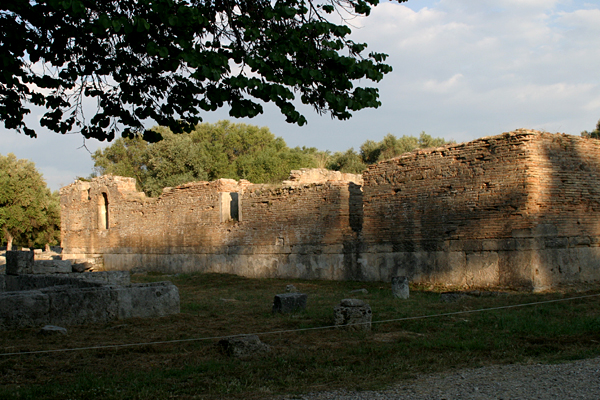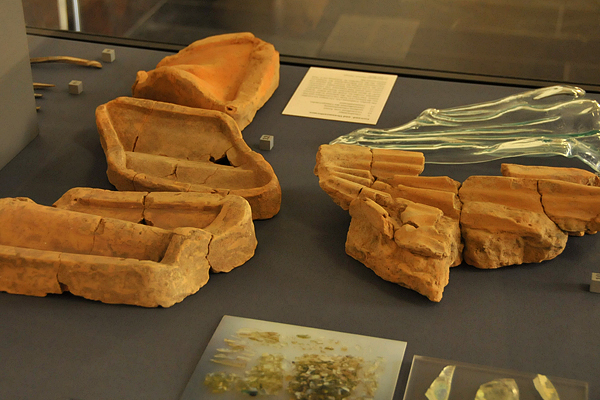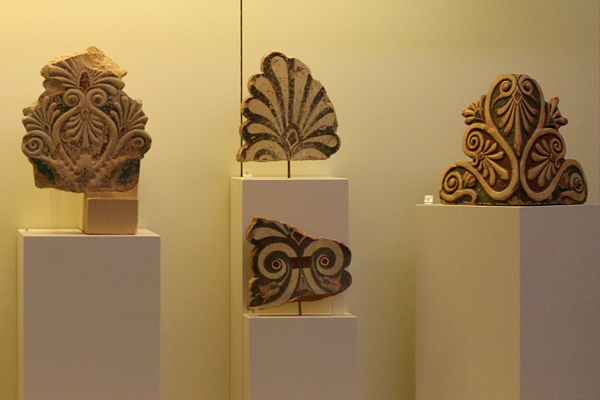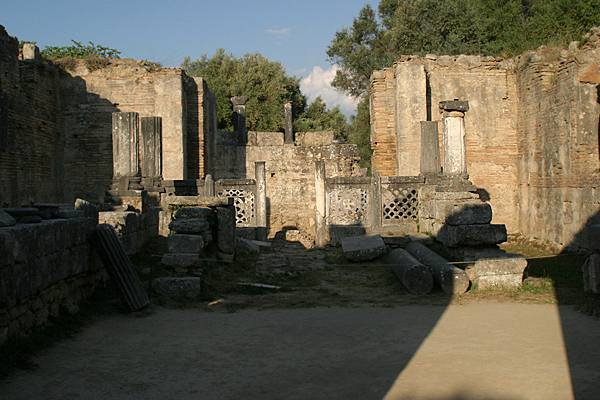
"Outside the Altis there is a building called the workshop of Pheidias, where he wrought the image of Zeus piece by piece. In the building is an altar to all the gods in common."
Pausanias, Description of Greece (V.15.1)
"On the other hand, Phidias is regarded as more gifted in his representation of gods station of men, and indeed for chryselephantine statues he is without a peer, as he would in truth be, even if he had produced nothing in this material beyond his Minerva at Athens and his Jupiter at Olympia in Elis, whose beauty is such that it is said to have added something even to the awe with which the god was already regarded: so perfectly did the majesty of the work give the impression of godhead."
Quintillian, Institutio Oratoria (XII.10.9)
"I was like those colossal statues, the work of Phidias, Myron or Praxiteles: they too look extremely well from outside: ’tis Poseidon with his trident, Zeus with his thunderbolt, all ivory and gold: but take a peep inside, and what have we? One tangle of bars, bolts, nails, planks, wedges, with pitch and mortar and everything that is unsightly; not to mention a possible colony of rats or mice. There you have royalty."
Lucian, The Cock
Directly west of the Temple of Zeus was the workshop where Pheidias crafted the chryselephantine statue of Zeus, considered one of the Seven Wonders of the ancient world. The rectangular workshop was built of shell-limestone and had the same dimensions as the cella of the Temple of Zeus, which allowed the artist better to judge the appearance of the statue in its setting. It was revetted with gold, ivory, and glass plaques over a wooden core and likely was transported in pieces and then assembled inside the Temple of Zeus, where the god is depicted as seated on a gold throne decorated with mythological scenes. The face and undraped parts of the body were of ivory, while the gold robe was adorned with glass flowers and semi-precious stones.

In the 1950s, German archaeologists excavated the site, where a large number of terracotta moulds were found. Depending upon their shape and size, they were used to render the folds of the statue's robe in glass, as can be seen in the exhibit in the Pergamon Museum (Berlin), or for making ornamental components. There also pieces of ivory and semi-precious stone, tools for working gold and ivory, glass leaves from a palmette, and, most significantly, a small black oinochoe or wine cup, on the bottom of which is inscribed "I am [the property of] Pheidias."

There is a large selection of moulds in the Archaeological Museum (Olympia), as well as a number of terracotta architectural ornaments from Pheidias' workshop, including antefixes (the decorative elements that terminate the roof tiles) with an anthemion or palmette. On the right is an acroterion from a corner of the pediment.

Sometime between AD 435-451, an early Christian basilica was erected over the ruined foundation of the building. It had two colonnades, which divided the interior into three naves, and an apsidal sanctuary at the east end. One still can see the low marble chancel screen. The basilica was destroyed by the earthquake of AD 551.
In the Twelfth or Olympic Discourse, which was delivered in AD 97 during the games at Olympus, Dio Chrysostom stood before the Temple of Zeus and spoke of the role of the sculptor in religion, arguing that an innate notion of the divine is strengthened by one's experience and observations of the world. In his Discourse, Dio uses Pheidias to express his own thoughts, having him declare that all his skill was used to create a statue worthy of the god. Pheidias says that he took his conception of Zeus from Homer and then compares the respective ability of poetry and sculpture to portray reality, with poetry having the advantage.
"But our art, on the other hand, that which is dependent on the workman's hand and the artist's creative touch, by no means attains to such freedom; but first we need a material substance, a material so tough that it will last, yet can be worked without much difficulty and consequently not easy to procure; we need, too, no small number of assistants. And then, in addition, the sculptor must have worked out for himself a design that shows each subject in one single posture, and that too a posture that admits of no movement and is unalterable, so perfected that it will comprise within itself the whole of the god's nature and power. But for the poets it is perfectly easy to include very many shapes and all sorts of attitudes in their poetry, adding movements and periods of rest to them according to what they consider fitting at any given time, and actions and spoken words, and they have, I imagine, an additional advantage in the matter of difficulty and that of time. For the poet when moved by one single conception and one single impulse of his soul draws forth an immense volume of verses, as if from a gushing spring of water, before the vision and the conception he had grasped can leave him and flow away. But of our art the execution is laborious and slow, advancing with difficulty a step at a time, the reason being, no doubt, that it must work with a rock-like and hard material. But the most difficult thing of all is that the sculptor must keep the very same image in his mind continuously until he finishes his work, which often takes many years" (69-71).
References: The Works of Lucian of Samosata (1905) translated by H. W. Fowler and F. G. Fowler; Quintilian: Training of an Orator (1920) translated by H. E. Butler (Loeb Classical Library); Dio Chrysostom (1939) translated by J. W. Cohoon (Loeb Classical Library).